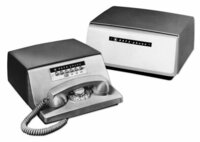The first commercial modem is manufactured
|
1962 It was in the 1950s that the first modems were being developed. There was a need to transmit data for North American air defense, so efforts were made to accomplish the goal of data transfer across the existing telephone wires. The air defense was using modems by the end of the 1950s, but the first commercial device was not available until 1962. It was called the Bell 103, by AT&T. This first modem allowed full-duplex transmission, and boasted data rates up to 300 bits per second. Shortly after the Bell 103, there came the Bell 212, which reached speeds of 1200 bits per second. It also employed a method of modulation called phase-shift keying (PSK). This was a step up from the frequency-shift keying (FSK) method that the Bell 103 employed. Over the next fifteen years, the efforts were to make the modems transmit data at a higher rate. In order to accomplish this, the telephone system required some improvement. As it was, due to mutual interference of signals being attenuated at various rates through the system, there was smearing of data symbols. To compensate for this, equalizers needed to be applied to the telephone lines. The automatic adaptive equalizer was invented in 1965 at Bell Laboratories by Robert Lucky. While equalizers had been used for some time, they required human intervention to be adjusted appropriately. With the advent of the automatic adaptive equalizer, data could be transmitted at high rates, as was desired. Modem technology also improved in this time, and by 1980, there existed modems that could transmit up to 14.4 kilobits per second over four-wire leased lines. By 1984, modems were to the point of transmitting 9.6 kilobits per second over a single-pair circuit on the telephone system. To make this a reality, advances were made in echo cancellation, which keeps the sending modem from picking up its transmitted signal on its own receiver. This problem, of course, only presented itself when trying to send high speed data over a single circuit. Additionally, a new coded modulation with error correcting codes was developed. This integral error correction made the signal less susceptible to noise. Using the same sort of technology, modem speeds were increased to 14.4 kilobits per second by 1991. Then, in 1994, it doubled to 28.8 kilobits per second. Soon after, there came 33.6, which was thought to be an upper limit for phone line transmisions. But along came the 56k modem, and a new set of standards, so the speeds continue to push the envelope of the capacity of the telephone system. Image:
|
Click on the Images For Detail
|










